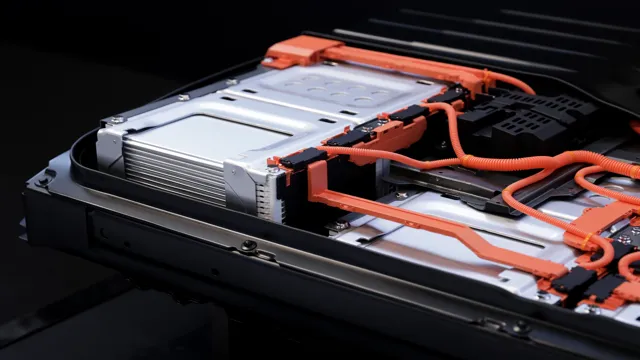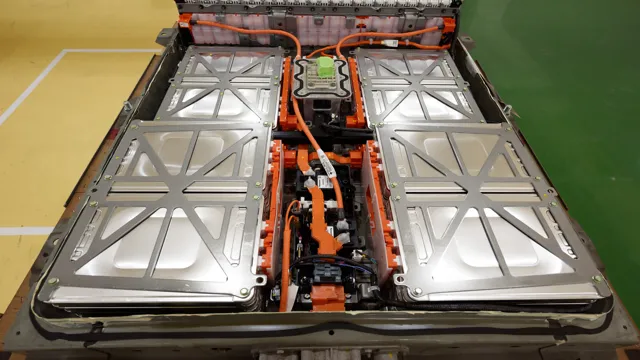Power up Your Drive with Electric Car Battery Bank: Revolutionizing the Automobile Industry
Electric cars are becoming increasingly popular, and for good reason. They are not only environmentally friendly but also cost-effective and efficient. One of the most crucial components of electric cars is their batteries.
As opposed to conventional cars, electric cars run on battery power. This is why the battery bank used in an electric vehicle is of utmost importance. But what exactly is an electric car battery bank? How does it work? And why is it critical to the overall performance of the car? In this blog, we will explore everything you need to know about electric car battery banks, from the basics to the technicalities, and everything in between.
So, buckle up and let’s dive into the world of electric car battery banks!
What is an electric car battery bank?
An electric car battery bank is essentially a grouping of rechargeable batteries that help power an electric vehicle. These battery banks are often made up of lithium-ion batteries and are designed to provide enough energy to run an electric motor. They are typically located in the floor area of the car, taking up significant space, and can provide enough energy to travel hundreds of miles on a single charge.
The battery bank is charged through regenerative braking, which captures energy during braking and converts it into stored energy in the battery bank. Additionally, some electric car battery banks can also be charged through plugging into an external power source. Despite their upfront cost, electric car battery banks can save drivers a significant amount of money over time in fuel costs and maintenance fees.
Providing continuous power to electric cars
Electric cars rely on their battery banks to provide the continuous power necessary for driving. A battery bank is a set of connected batteries that work together to store and release energy. In electric cars, these battery banks are usually made up of hundreds of individual lithium-ion batteries, which are known for their ability to hold a large amount of energy in a compact size.
The battery banks are responsible for storing energy when the car is not in use, and then releasing it as needed to power the electric motor that drives the car. Essentially, the battery bank is the heart of an electric car, and without it, the car cannot function. Fortunately, as technology has advanced, electric car battery banks have become more efficient, allowing for longer ranges and faster charging times.
However, implementing infrastructure for charging on-the-go is still a challenge to overcome.

Storing and delivering electric energy
An electric car battery bank is a collection of battery cells that store and deliver electric energy to power the vehicle. These battery banks come in different configurations and capacities, depending on the car’s make and model. Typically, electric car battery banks contain lithium-ion battery cells, which have a higher energy density compared to other battery types.
This allows electric cars to travel longer distances on a single charge. The battery banks are rechargeable and can be charged using a standard household outlet or from a charging station located at various public locations. Think of the electric car battery bank as the fuel tank of a traditional gasoline car, but instead of filling up at a gas station, you charge it up.
With advancements in technology, battery banks are becoming smaller and more efficient, allowing electric cars to become more practical and affordable for everyday use.
Advantages of using an electric car battery bank
Electric car battery banks are becoming increasingly popular due to their many advantages. One major advantage is that they allow for more efficient use of energy. Instead of relying solely on the car’s battery, drivers can charge the battery bank at home when electricity is cheapest and then use that stored energy to power their car during peak hours.
This not only saves money on energy costs, but it also helps to reduce strain on the electrical grid and promotes greater energy independence. Additionally, electric car battery banks are a more sustainable option than traditional gasoline-powered cars. They produce zero emissions, which helps to reduce air pollution and combat climate change.
Overall, investing in an electric car battery bank can provide significant financial and environmental benefits in the long run.
Reduced dependence on fossil fuels
Reduced dependence on fossil fuels. Electric cars are becoming increasingly popular and with good reason. One advantage of using an electric car battery bank is its contribution to reducing our dependence on fossil fuels.
It’s no secret that traditional cars pollute the environment, contributing to climate change and numerous health issues. However, electric cars are powered by rechargeable batteries that do not emit harmful pollutants into the atmosphere. Additionally, an electric car battery bank can be charged using renewable energy sources such as solar power.
This means that not only are electric cars good for the environment, but they also offer a sustainable solution to our energy needs. Using electric cars has become an important step towards achieving a greener future, and it’s up to each one of us to do our part in reducing our dependence on fossil fuels.
Reduced carbon emissions
Reduced carbon emissions Switching to an electric car battery bank can have numerous advantages, one of which is significantly reduced carbon emissions. Electric vehicles (EVs) emit zero tailpipe emissions, meaning they don’t produce the harmful pollutants that traditional gas-powered vehicles do. This is because EVs operate on electricity stored in their battery banks, eliminating the need for gas consumption.
The environmental benefits of using an electric car battery bank go beyond just reducing carbon emissions, too. There’s also less noise pollution, reduced dependence on fossil fuels, and improved air quality. Plus, many states offer incentives for EV owners, such as tax credits and rebates, making it an even more appealing option for those looking to reduce their carbon footprint.
By making the switch to an electric car battery bank, you can help to reduce your impact on the environment while enjoying all the benefits of owning an efficient, high-tech vehicle.
Lower cost of ownership
If you’re looking to save money on your vehicle’s operating costs, then you might want to consider investing in an electric car battery bank. One of the main advantages of using an electric car battery bank is the lower cost of ownership that it provides. Unlike gasoline-powered vehicles that require frequent trips to the gas station, electric cars can be charged at home and at a much lower cost.
In fact, studies show that it can cost up to 50% less to fuel an electric car compared to a traditional gasoline-powered vehicle. Additionally, electric cars require significantly less maintenance than traditional cars, which means less money spent on repairs and upkeep over time. By investing in an electric car battery bank, you’ll enjoy lower operating costs and a more sustainable and eco-friendly way to get around.
So why not consider making the switch today?
Types of electric car batteries
When it comes to electric car batteries, there are three main types: nickel-metal hydride (NiMH), lithium-ion (Li-ion), and lead-acid. NiMH batteries were commonly used in the early days of electric cars, but they’ve mostly been replaced by Li-ion. Li-ion batteries are lighter and have a higher energy density, which means they can store more energy in a smaller space.
Lead-acid batteries are the least expensive of the three, but they’re also the heaviest and have a lower energy density. No matter what type of battery your electric car uses, it will have a battery bank made up of several individual batteries. This battery bank is what allows your car to drive for miles on a single charge, and it’s important to maintain it properly to get the most out of your electric car.
Lithium-ion batteries
When it comes to electric car batteries, there are a few different types to choose from. One of the most popular options on the market today is the lithium-ion battery. These batteries are known for their relatively lightweight and compact design, making them a great choice for electric car manufacturers looking to maximize space and efficiency.
Lithium-ion batteries work by storing energy in a chemical reaction between two materials: a lithium-ion-rich cathode and a carbon-based anode. This process allows for the battery to store and release energy quickly, making it perfect for use in electric cars. Additionally, lithium-ion batteries can be recharged many times over their lifetime, making them a cost-effective and environmentally-friendly choice.
Whether you are in the market for a new electric car or simply looking to learn more about the technology behind these impressive machines, lithium-ion batteries are definitely worth considering.
Lead-acid batteries
Lead-acid batteries are one of the oldest types of electric car batteries on the market. They have been around for over a century and are still used in some electric cars today. These batteries are made up of lead and sulfuric acid and are reliable and affordable.
However, they have some drawbacks, such as being heavy and having a limited lifespan. Despite these limitations, lead-acid batteries are still widely used as a backup power source for electric cars. They are also popular for use in golf carts, electric scooters, and other low-speed vehicles.
While there are newer and more advanced types of electric car batteries available today, lead-acid batteries still have their place in the market.
Factors to consider when choosing an electric car battery bank
Choosing an electric car battery bank can be a daunting task, as there are different factors to consider before making a decision. One crucial factor is the size of the battery bank, which determines the driving range of the vehicle. A bigger battery bank means a longer driving range, but it also makes the car heavier and more expensive.
Another factor is the type of battery chemistry, as different chemistries have different characteristics in terms of lifespan, efficiency, and environmental impact. Lithium-ion batteries are the most common type used in electric cars, but there are also newer options like solid-state batteries that promise higher energy density and safety. Moreover, it is also important to consider the charging infrastructure, as not all charging stations are compatible with every electric car model.
Therefore, it is advisable to choose a battery bank that is compatible with a wide range of charging options to avoid inconvenience while on the road. In conclusion, selecting the right electric car battery bank requires careful consideration of various factors to ensure optimal performance, efficiency, and convenience.
Capacity and range
When it comes to choosing an electric car battery bank, there are several factors to consider, with capacity and range being two of the most important. The capacity of a battery refers to how much energy it can store, while the range is the distance the car can travel on a single charge. It’s essential to choose a battery bank with a capacity that meets your daily driving needs.
A larger capacity battery will provide longer range, but it’s also heavier and more expensive. The range is also affected by other factors like weather conditions, driving style, and terrain. To maximize the range, it’s crucial to drive smoothly and plan your trips carefully.
Ultimately, the right battery bank for your electric car will depend on your driving habits and needs.
Charging time
When it comes to choosing an electric car battery bank, charging time is a crucial factor to consider. Nobody wants to waste their time waiting for their car battery to charge when they could be driving. The charging time for an electric car battery is affected by several factors, such as the size of the battery, the charging station’s power, and the type of charging port used.
Additionally, some electric cars come with fast-charging capabilities that can significantly reduce charging time. However, be aware that these capabilities may not be available on all models. In summary, it’s essential to evaluate the battery’s size, the charging station’s strength, and the charging port’s type to determine a car’s charging time when shopping for an electric vehicle.
Durability and lifespan
When it comes to electric car battery banks, durability and lifespan are crucial considerations. One of the primary factors to consider is the type of battery chemistry used in the battery bank. Lithium-ion batteries are known for their high energy density and longer lifespan compared to other battery types.
However, it is also important to consider the specific battery management system (BMS) used in the battery bank. A well-designed BMS can help prevent overcharging and overheating, which can significantly extend the battery’s lifespan. Another factor to consider is the quality of the battery cells used in the battery banks.
Cells with a higher quality can handle more charge cycles and provide better performance over time. Finally, regular maintenance and proper charging habits can also help extend the lifespan of an electric car battery bank. Overall, investing in a high-quality battery bank and taking proper care of it is essential for ensuring the longevity and durability of an electric car’s power source.
Conclusion
In conclusion, an electric car battery bank is the brain and brawn that power your environmentally friendly vehicle. While it may not have the heart of a classic muscle car, it certainly has the technology and ingenuity to take you the distance and with zero emissions. So, plug in, buckle up, and let your battery bank be your guide to a greener future.
“
FAQs
What is an electric car battery bank?
An electric car battery bank is a system of interconnected batteries that store the electrical energy needed to power an electric car.
How long does an electric car battery bank last?
The lifespan of an electric car battery bank depends on various factors such as usage, temperature, and maintenance. Generally, it can last from 8-10 years or even longer.
Can an electric car battery bank be replaced?
Yes, an electric car battery bank can be replaced. However, it can be an expensive process, so it is recommended to maintain the battery bank to prolong its lifespan.
How eco-friendly is an electric car battery bank?
Electric car battery banks are considered eco-friendly because they don’t emit harmful pollutants like traditional gasoline cars. However, the production process of batteries might have some environmental impact.





